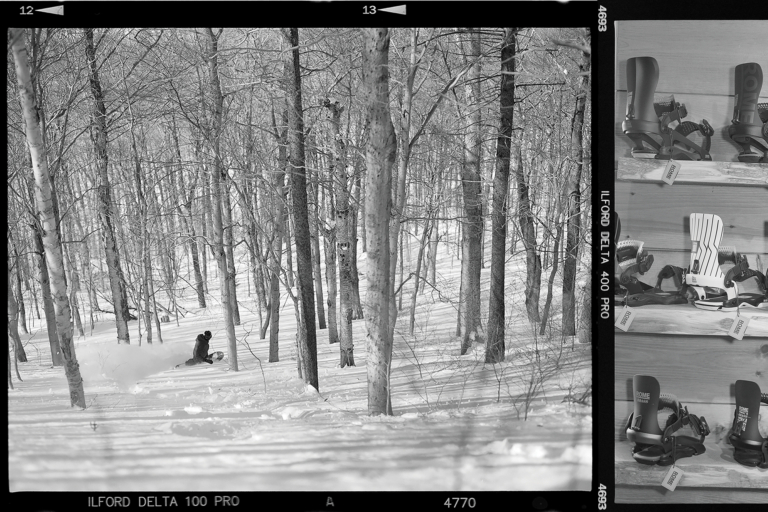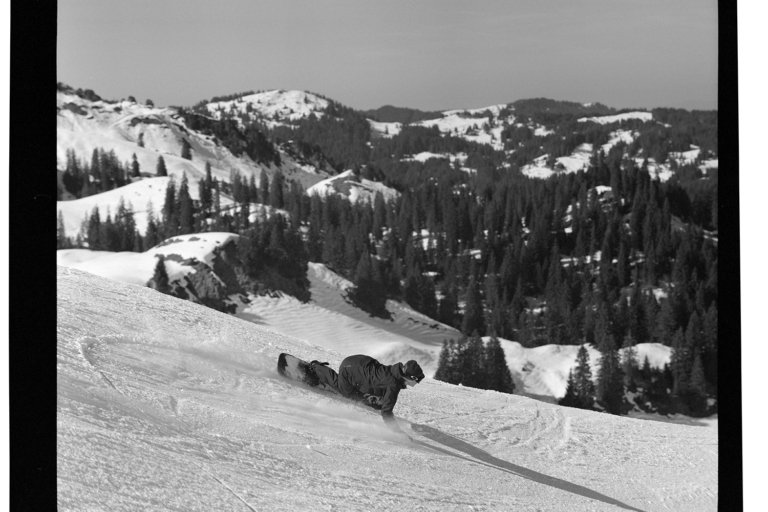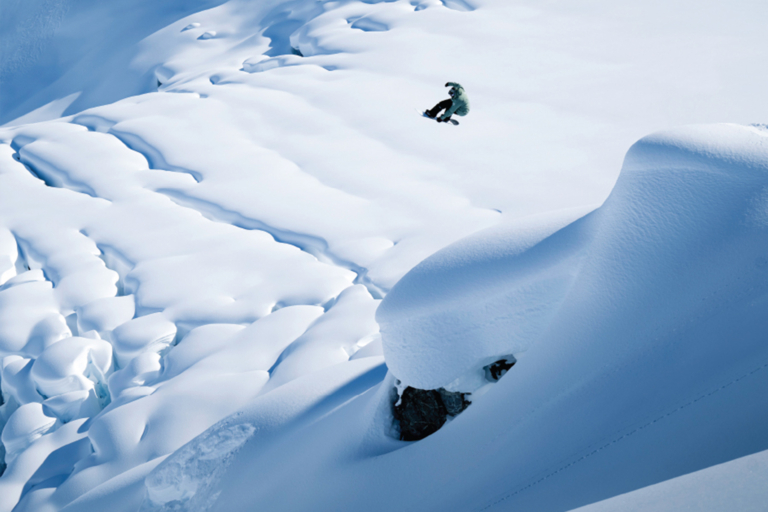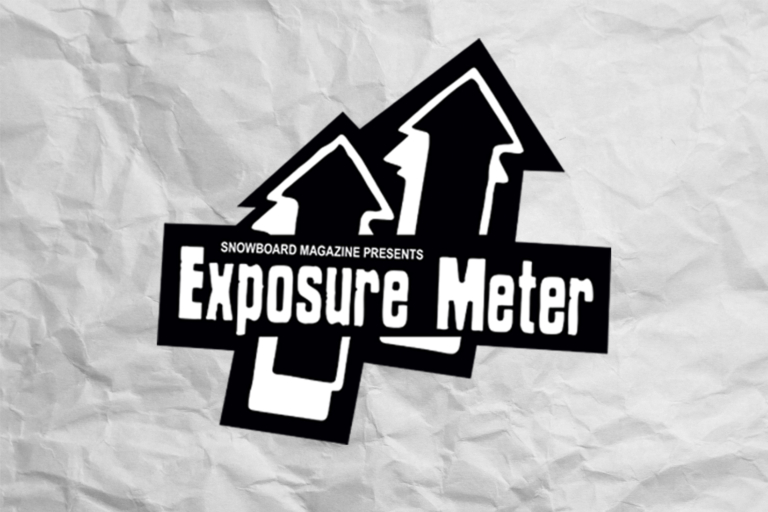Nestled in the southeastern corner of British Columbia directly north of the border to Washington, Idaho, and Montana, lies Canada’s Kootenay region. The Kootenays are made up of small, eclectic mountain communities that give off a real neighborly vibe with a DIY foundation. It’s where big terrain meets small-town mentality. The perfect storm for the wise-beyond-her-years Estelle Pensiero to pursue her goal of becoming a guide. Hailing from Nelson—the big smoke of the Western Kootenays—20-year-old Estelle came up riding at her family-owned backcountry lodge, Baldface, absorbing elements of style, attitude, and intention from the legends and heroes that frequent the lodge. Estelle essentially started snowboarding at Baldface and has spent years curating an effortless and elegant style alongside an inquisitive approach to snow safety. We saw her film debut in Robin Van Gyn’s series Fabric, before she was tapped by Pat Moore to join his project, Candle, as part of the Arbor team. Things are moving quickly for Estelle; she spent the last year travelling consistently with the likes of The Wildcats and Real Wild Kittens, as well as the Arbor and Volcom teams. Amidst her burgeoning career, she’s hyper aware of her access to opportunity and hosted her first event, Low Maintenance, last season, focusing on creating new opportunities for riders to get into the backcountry. She’s one to watch, a true product of her environment who keeps the wheels turning with big goals and an earnest approach. – Ally Watson
Originally published in Volume 20, Issue 1.

To get things started, how would you describe your roots in snowboarding?
I’m from Nelson and I have lived here my whole life. My dad started Baldface Lodge and I’ve grown up there. That’s how I got into snowboarding, so I have been riding the backcountry mostly. Through Baldface, I’ve been wanting to get into more of the guiding aspect of snowboarding. In the last few years that’s what I have been focusing on, getting my certificates and spending as much time in the backcountry as I can so I can be a bit more well-versed. I guess that’s kind of my origin: Baldface, backcountry, guiding, Nelson—that’s me!
That lends to the culture of the Kootenays too. There’s not a strong park culture there, so a lot of people start freeriding first and the freestyle component of their riding takes place on natural features.
Yeah! It’s kind of a crazy path. My home mountain is Whitewater, and they don’t really have a park—it’s not really the main attraction. It’s a good Kootenay story to start your career in the backcountry. It’s so easy for me to say this because I’ve grown up here and have access, but most people start in the park because the backcountry isn’t accessible. You have to have knowledge, equipment, and you kind of have to have money. I’m super grateful to be born into it.
You had a busy winter and travel schedule last season. How have you been managing that?
Before 2021, I never really travelled out of North America, and then I went to Europe, and it was crazy to realize how big the world is. The thing that tripped me up the most is the languages. I was thinking that every language has words for everything, and the world is just so big. It’s the coolest thing ever. My travel comes from team trips and opportunities with my sponsors. I’m in love with travelling.

Do you have a favorite trip you went on last winter?
Oh gosh, Japan was insane! Japan is the best place ever. There’s so much history and the food was so good. I went to Europe two times. I went to Innsbruck at the beginning of the season with Juliette Pelchat. She’s one of my best friends and I went to Japan with her as well, but in Europe, she was training with the Canada snowboard team and I was just there, training with myself, I guess, and it was so much fun!
You spent a lot of time with Arbor as a new addition to Candle. How does it feel to be a part of such a unique new part of the Arbor brand?
It feels so good. I was stoked to be on Arbor, and then to be part of Pat’s thing is just so cool because he has this clear vision for where it’s going to go. All the things I appreciate about snowboarding and about Arbor are what Pat is doing with Candle. It’s really cool to be a part of something that I’m so aligned with and Pat is so passionate about. It’s makes me more passionate about it. It’s cool to be with something from the ground up.
Pat talks about helping the next generation and fostering new growth with Candle. How do you feel like you fit into that?
Mentorship and bringing new people into snowboarding is something that I’ve been more and more passionate about. Pat has been a mentor to me my whole life and to make it a bit more official is super aligned with what I think snowboarding needs more of. I think that mentorship is the most important thing in snowboarding.
With your intentions to become a guide, how do you think that growing up at Baldface and finding mentorship there has helped you fine-tune your goals in snowboarding?
I think that mentorship can look like a lot of different things. I’ve always been so interested in snow safety and snow science. Maybe from just being around the guides at the lodge and seeing Pat who’s a super renowned, amazing snowboarder and then he’s moving into snow safety, I was like, “Oh, maybe I can do this too.” With Pat’s Risk Maturity course, I saw you can really find a way to balance guiding and snowboarding.

It’s like an invitation to be involved.
There’s always going to be somebody that’s giving you a bit of advice and mentoring you, or even teaching you. Of course, in the Kootenays there’s so much accessible backcountry, but if you don’t have people mentoring you along the way, you’re never going to get on the right trajectory to be knowledgeable and safe while taking the right amount of risk in the backcountry.
It’s definitely a never-ending road where you’re never an expert, you’re always learning.
The people that I’m the most excited to spend time in the backcountry with are people like Pat who give you a chance to develop your own intuition and ask you questions. With Pat, he’d be like, “Okay, so I don’t think this feels safe because of all these reasons and I found this in my snow profile.” Then he would ask me how I felt and why. No matter how much time you’ve spent in the backcountry, you still have a gut feeling and to be recognized is the only way to develop it.
That’s so true. And you haven’t just been a visitor in the backcountry, you’ve been an immersed participant. What has influenced you to take on that approach?
That’s a good way to put it, I think. Anybody who’s willing to learn can be an immersed participant. If you ask a question and you’re curious, you’ll be involved. If you were going out with somebody and they just made all the decisions and didn’t ask your input on anything, you wouldn’t feel like you had a place to give input on anything. I think to feel safe in an environment, to feel safe enough to ask questions and to give input, you have to be given a space where you’re not brushed aside. It’s really important always to be speaking up if you feel a certain way about something, especially in a situation where it’s life and death, like in avalanche terrain.

Who’s one of your most prominent mentors?
The first person who was showing me the way was Robin Van Gyn. She has been coming to Baldface for a long time and I’ve known her for my whole life. We were kind of becoming friends a bit more and she took her courses and became a guide. I got to see someone who became a professional snowboarder and then became a guide, and I knew that’s exactly what I wanted to do. Robin gave me so much. When she filmed FABRIC, she was like, “Estelle, I really want you to be a part of this.” She was just showing me so much and it was tangible for me. I could follow in her footsteps, and she recognized that and took me under her wing.
And you get to spend so much time with legends of snowboarding as they come up to the lodge.
It’s just so sick and it’s something I would never take for granted, being able to really ride with my heroes. I’m really living the dream to have that mentorship.
On that topic, what inspired you to create Low Maintenance?
I’ve always in my life had this guilt. I’ve just been born into something that everyone else works so hard to get. It doesn’t feel good to just be sitting there with all this privilege. Instead of just feeling bad about it, I was thinking, Maybe I can find a way to give other people the same privilege that I have. Somebody once said to me, “A rising tide lifts all boats.” I wanted to find a way to lift others up so I can make it easier for people to get into the backcountry. At the end of the season, my dad wanted to have an event. I asked him if I could be involved, and he was so inclusive every step of the way. Everyone in snowboarding has their own circle. Like I know my people, but I don’t know that many people that are trying to get into it. All the people I have met have already been to Baldface, and they don’t need the opportunity. So, I decided that I could get all the people that have been good mentors to me to come up to the lodge and bring somebody else that they would think wouldn’t otherwise have the opportunity.

To extend the circle.
Yeah, exactly. Every pro that I invited brought somebody with them. It was such a good mix. The mentorship happened so organically. It’s a whole different animal riding in the backcountry, and it was exactly how I wanted it to go down.
So, what was the format like?
We built a flow park in front of the lodge because we got the tow rope this year. Everyone came and it snowed so much. We were like, Okay, we are at Baldface, we aren’t riding a park. The first night, we had the cat set up with the lights on the quarterpipe and we had a nighttime session that brought everyone together a bit. The next day, we rode the Supernatural course. We just lapped it, which isn’t normal. It’s super steep and a frequent avalanche slope, but the conditions were so good and everyone was so keen. We didn’t have a schedule and took it day by day. It was organic to let people do what they want.
What’s your plan for your path to guiding? Are you going with the ACMG (Association of Canadian Mountain Guides) or CSGA (Canadian Ski Guide Association)?
CSGA. I took my CAA (Canadian Avalanche Association) level one last December. You can work with your CAA level one, but you want to have your CSGA, too. I’m looking to get the CSGA course done in the beginning of the season and recert or upgrade my first aid. Then I’m thinking, Do I really want to work at Baldface? With my qualifications and experience, if my last name wasn’t Pensiero, I probably wouldn’t have a job there. I would really like to go work somewhere else to get experience. As much as I would like to deny it, I have special treatment at Baldface, so to go somewhere else and see how a different operation works would be good. All the guides at Baldface are like my family, but I know their style and I would like to learn from other people. Once I have more experience, I can come back and work at Baldface as a really solid part of the team where I would be an asset rather than someone who is just entitled to be there.
Seeing how other operations work is so vital to being a successful, well-rounded guide, too.
For sure! Working at a cat skiing place is different from a touring hut or a heli operation. I would like to learn more about touring and get my splitboarding really dialled in. There’s lots of different options, and guiding isn’t the only one. There are people that are so into weather—you could be a forecaster, you could do avalanche highway control. I think the best guides are people that can look at things from different perspectives.
Yeah. You spend a lot of time with John “Buff” Buffery, too, who is a great example of that.
Yes, I was totally thinking about Buff. It’s so cliché and everyone says it, but Buff is really the backcountry guru. He’s done everything and that’s why he’s so well-versed. It’s dangerous to get comfortable. You have to have an idea of your bias. You need to take into account all the factors that make habits, so that you never get into a habit.
It’s so great that you are able to speak to all that. It’s such a broad learning process.
Exactly. And I feel kind of the same way with snowboarding. My snowboarding is really specific. I kind of only know how to ride backcountry and it’s a bit of a suspicious thing to say—it seems really privileged. For my next step, I really want to become a more well-versed snowboarder because the backcountry isn’t everywhere. I’m not so good at riding park and I just want to branch out.
It’s just that your path is your own and different than a lot of backcountry riders who have their roots in freestyle park riding.
Exactly, because that’s just the trajectory of being a snowboarder. You ride park, you compete, you’re successful. People start sponsoring you and then you go on your first backcountry trip and fall in love with the backcountry and become successful there. That’s just the way it is. It’s a good way, but it’s just not the way I did it. It’s a super self-doubting thing, but who cares if people think I’m bad? I’m not supposed to be good at riding park. Honestly, I’m not ever trying to be the person who’s doing a ten on a park jump. I don’t think I’ll ever get to that point. And that’s okay with me because it’s not like I’m training to go to the Olympics. I’m training to be a guide. I’m really stoked to be in a time in snowboarding where not everybody’s career looks the same and that’s okay. It feels like everything in the world is more inclusive these days, snowboarding included. You can be from any walk of life and snowboarding will welcome you.






